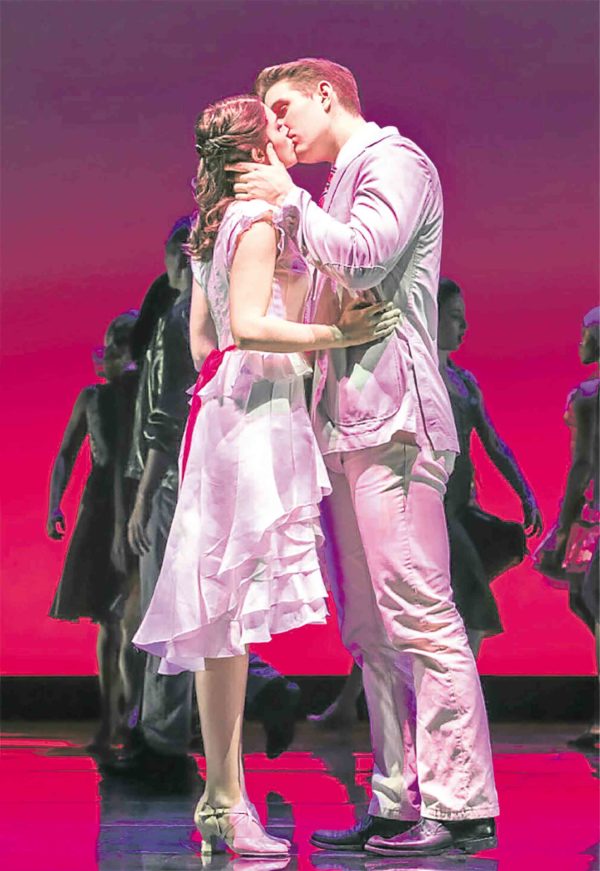
“West Side Story” actors Jenna Burns (left) and Kevin Hack
On Saturday night, my mother Ligaya, daughter Nicole and I saw “West Side Story” at the Theatre at Solaire. It was an invitation we couldn’t refuse as “West Side Story” remains one of my favorite musicals.
The film starring Natalie Wood as Maria, Richard Beymer as Tony, Russ Tamblyn as Riff, and Oscar winners George Chakiris as Bernardo and Rita Moreno as the fiery Anita always brings a tear to my eye.
This “Romeo and Juliet” love story set on the Upper West Side of Manhattan is hailed as one of the best movie musicals of all time, thanks to Leonard Bernstein’s melodies, Stephen Sondheim’s lyrics, Ernest Lehman’s screenplay (the original book for the stage musical was written by Arthur Laurents), Jerome Robbins’ choreography and Robert Wise’s direction.
I have no idea how many times I’ve seen the film, plus previous productions staged here at home (the last one was mounted by Stages, with Christian Bautista as Tony, and Joanna Ampil and Karylle alternating as Maria).
As I settled into my seat, I was hoping for excitement, the same giddiness that I felt in my youth whenever I watched the film. And, sure enough, the cast delivered on its promises. Great dancing, and near-flawless singing (particularly from the actors playing the main protagonists, Kevin Hack as Tony and Jenna Burns as Maria), and simple yet effective use of projection and moving scenery.
What I didn’t expect, given the current political climate and racial tensions in the United States, was a punch in the gut the moment the Jets and the Sharks appeared.
The Jets, all white and pale, slim and tall, representing whatever fair-skinned European ancestry had immigrated to America a century before, and the Sharks, all shades of brown representing the tiny island of Puerto Rico, the immigrants of what was 1950s America.
The two gangs made up of teenage boys are engaged in a turf war. The police are trying to clean it up (while showing shades of bias toward one side … guess which one), the adults are trying to teach life lessons, and the kids are about to kill each other, literally.
In war, people die. And no one is left unaffected. Not even the audience. And perhaps, this is the power of art: to display, in a safe space, human frailty. The consequences of one’s actions. That road to hell paved with everyone’s good intentions. The endless finger-pointing, the placing of blame squarely on “the other guy,” without contemplating that perhaps, oneself is as much to blame.
It is at times like these that art is required, important and necessary. Not just to entertain, but to place us all in front of a mirror to show us our mistakes, what we’re doing wrong.
“West Side Story” landed on Broadway in 1957, and even 60 years ago, this musical was calling it. It is as topical today as it was back then.
It takes a special kind of courage to create this kind of art, the kind that not everyone will like (the show didn’t win the Tony for best musical … kind of hard to believe, given its now-legendary status).
The critics were divided, and it wasn’t until it crossed the pond to the West End in 1958 and made its Hollywood debut in 1961 (winning 10 Oscars in the process) that it became a resounding success. Its legend is bolstered further by how contemporary the issues still feel, and how timely the subject matter is.
To the company of the Manila season of “West Side Story,” thank you for paying our shores a visit. Perhaps in watching this show of two warring sides, we will realize that in a fight of us versus them, no one ever wins. It is a lesson that many of us have forgotten, and it’s in shows like yours that we’re reminded in jarring fashion.
Next to play at the Theatre at Solaire is the Rodgers and Hammerstein classic, “The Sound of Music.” Let’s remember that this musical was set against the backdrop of Nazi Germany, and how that part of history must not ever be repeated.